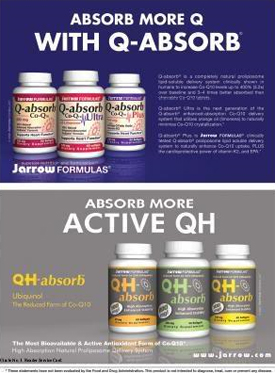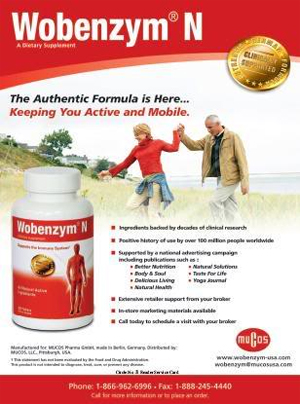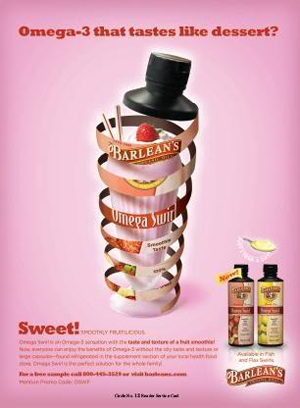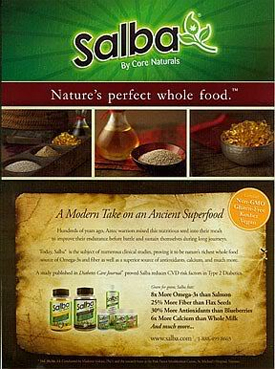What’s old is new and what’s new is old. The ingredients in natural supplements are, in most cases, as old as the Earth itself, but the industry is far from stagnant. Its growth is continuous as it reinvents traditional supplements with cutting-edge delivery technologies, new flavors and textures, unique sourcing options and sophisticated production techniques. Innovative ideas are the working gears of the natural products industry, as illustrated by the following next-generation supplements.
Burn, Baby, Burn
For both aesthetic and health reasons, weight-management products have lured consumers to our industry for years. Numerous research-backed products have achieved market success, but industry insiders are adding another innovative product to the list of weight-loss category standouts: fucoxanthin.
Research shows that this antioxidant derived from seaweed helps burn fat, according to Francisco Rodriguez, manager of research and science at Garden of Life, West Palm Beach, FL, the manufacturer of fucoThin (fucoxanthin plus pomegranate seed oil). “Other products either make you feel full or stimulate the nervous system to provide the same effect. Fucoxanthin is a thermogenic that promotes the fat-burning process,” he says. Those who exercise and eat healthy diets have reported weight loss results.
Though the company’s fucoxanthin product is different, Deborah B. Vickery, MBA, director of product development at Nutraceuticals International LLC, Elmwood, NJ, agrees fat-burning properties make the extract a stand-out. “It truly does represent the discovery of a completely new theory in combating weight loss and obesity. It is unlike any other product in the weight-loss category,” she explains. “It is not an overall metabolic stimulant like Ephedra was. It is not an appetite suppressant like Hoodia gordonii, or a lipid, or a carb blocker.” In the case of Nutraceuticals International’s FucoPure 10% fucoxanthin, “it is going after the source of the problem and targeting the key issues associated with obesity and type II diabetes, namely stored fat accumulation in the abdominal region and lower insulin resistance caused by elevated blood glucose.” Rather than initiating weight loss by absorbing the fat from food or creating satiety, it is Non-Stimulant Micro-Thermogensis that targets abdominal fat and metabolizes it at the cellular level, says Vickery. Nutraceuticals International also manufactures FucoPure 5% HPLC fucoxanthin extract, water-dispersible FucoPure 5% (for shake and drink applications), private label fucoxanthin and FucoPure 10% fucoxanthin with omega-3.
 Like other powerful antioxidants, Rodriguez notes that fucoxanthin also helps fight against free radicals and has an effect on C-reactive protein, triglycerides and blood pressure, “making it a prime candidate for heart health.”
Like other powerful antioxidants, Rodriguez notes that fucoxanthin also helps fight against free radicals and has an effect on C-reactive protein, triglycerides and blood pressure, “making it a prime candidate for heart health.”
And the best may be yet to come, as innovation continues on this unique product. “There are some great trends that I see happening with fucoxanthin,” says Rodriguez. “More research is showing that fucoxanthin and oils, like those in coconut oil, appear to have a great synergistic effect…There are certainly some combination concepts to look forward to and Garden of Life will be at the forefront of those concepts.”
Nutraceuticals has already worked with experts to tweak their novel fucoxanthin formulation and blend it with omega-3 fatty acids for “optimal absorption, overall health and maximum weight-loss benefit,” says Vickery.
We may also see fucoxanthin take personal care aisles by storm. Nutraceuticals International is planning the launch of a FucoPure fucoxanthin extract specifically designed for topical skincare products.
Next in Line for Superfruit Fame
Noni, mangosteen, pomegranate and other nutritious fruits occupy important spaces in the superfruit hall of fame, and rightly so. These foods have high ORAC values and other properties that, when taken in supplement form, can offer important health benefits. While companies are regularly investigating and testing exotic and nutritious fruits for inclusion in supplements, WholeFoods would like to bring a few to your attention that have impressive nutritional value and may be the next stars of the superfruit circuit.
Maqui berry has been used in Chile since ancient times for strength, stamina, ulcer relief, sore throat relief and more. Given the harsh environment in which it grows, the purple berry evolved with anthocyanins and polyphenol antioxidants to protect it from scorching sunlight, diseases and biological enemies. According to Annie Eng, president, and Carlos Escalante, COO of Novelle International, Inc., Bradenton, FL (a manufacturer of Organic Maqui Superberry supplements), the berry has “one of the highest antioxidant levels known in the world.” The berry, for which Novelle is working to achieve organic status, has an ORAC value of 4,000.
Eng and Escalante note that this superfruit has strong research backing, including some projects sponsored by the World Health Organization. According to studies, maqui berry “inhibits the NF-kappaB gene, a key regulator of our inflammatory and immune response system that controls a range of pro-inflammatory cytokines. Maqui also reduces the over-expression of COX-2 enzymes and may be useful for supporting healthy joint function,” they explain. Over-expression of COX-2 may be related to chronic inflammatory diseases such as arthritis. “By suppressing COX-2, maqui may help alleviate arthritic conditions,” explain Eng and Escalante. In addition, the pair notes that maqui has been studied in cancer patients. “Our scientific team showed in an in vitro cell study that maqui berry concentrate reduces the viability of CACO2 (human colon cancer cells) and human leukemia (HL-60) cells, and induces cancer cell apoptosis (cell death). However, this research is not intended to show whether maqui berry can prevent or treat cancer in people as this was only a cell-culture model and has not yet been tested in humans,” they say, noting that the results are encouraging nonetheless.
Despite its great potential, Eng and Escalante (also of HP Ingredients, which supplies maqui extract as an ingredient to manufacturers) have said that they will select projects from manufacturers carefully and will not allow it to be commoditized and degraded.
 Phyllanthus emblica (Indian Gooseberry) shows great potential as a synergistic antioxidant ingredient in combination with other fruit juices and extracts like pomegranate. According to Lucien Hernandez, president of Natreon, Inc. (supplier of the Capros Phyllanthus emblica ingredient), “The implications for the development of an even more ‘super’ superfruit substance are vast, as the study shows that Capros combined with popular pomegranate fruit extracts and juices means increased potency for even more powerful and long-lasting health benefits. Capros patented nutritional supplement ingredient can positively impact health and vitality as a cascading antioxidant ingredient—and can give an antioxidant boost to other superfruit beverages, compounds and ingredients.” Studies on Capros indicate that the ingredient “helps overcome oxidative stress,” making it a good fit for several categories including environmental stress relief, digestive health, cardiovascular health, liver health and skin health.
Phyllanthus emblica (Indian Gooseberry) shows great potential as a synergistic antioxidant ingredient in combination with other fruit juices and extracts like pomegranate. According to Lucien Hernandez, president of Natreon, Inc. (supplier of the Capros Phyllanthus emblica ingredient), “The implications for the development of an even more ‘super’ superfruit substance are vast, as the study shows that Capros combined with popular pomegranate fruit extracts and juices means increased potency for even more powerful and long-lasting health benefits. Capros patented nutritional supplement ingredient can positively impact health and vitality as a cascading antioxidant ingredient—and can give an antioxidant boost to other superfruit beverages, compounds and ingredients.” Studies on Capros indicate that the ingredient “helps overcome oxidative stress,” making it a good fit for several categories including environmental stress relief, digestive health, cardiovascular health, liver health and skin health.
Blackcurrant has also been making a splash, but not for just the typical reason. “Most superfruits have achieved their renown because of their high antioxidant potential (which, in a general sense, may have a variety of applications from promoting a healthy inflammatory response to maintaining healthy cell replication),” says Kevin M. Connolly, Ph.D., director of scientific affairs and product development at Jarrow Formulas, Los Angeles, CA. “However, many of the interesting superfruit nutrients that we incorporate into our supplements have displayed additional activities that are not strictly ‘antioxidant’ (such as the phytoestrogenic potential of pomegranate lignans, the anti-adhesive polyphenol polymers in cranberry, or the ocular capillary-protecting anthocyanins of black currant).”
In fact, New Zealand blackcurrant is one of the most antioxidant-rich berries known, says Connolly. But notably, its “unique protective effects on eye health, especially on the reduction of eye fatigue associated with chronic exposure to terminal (e.g., computer) screens are mainly due to its high concentration of the unique polyphenols delphinidinin-3-rutinosde and cyanidin-3
-rutinoside.” Jarrow Formulas recently introduced PomeGreat Pomegranate + Blackcurrant + Red Grape Juice Concentrate, that offers an ORAC value of 2800 per serving.
Other interesting superfruits to keep an eye on include cupuacu, camu camu, acerola and lycee, which may expand the category. However, be sure to keep the other eye fixed on the relevant supporting research as it develops.
Ancient Grain Heats Things Up
The number of food and beverage products featuring ancient grains has doubled since 2005, according to Datamonitor’s Productscan database. The reason may be that mass consumers understand that whole grains are “the ultimate in health, notably in areas of cardiovascular and blood-sugar response support,” says Dean Mosca, president of Proprietary Nutritionals, Inc. (PNI), Kearny, NJ. “This opens the doors of opportunity for more novel, flavorful grains from around the world that can provide outstanding nutritional profiles beyond the well-known benefits.” One such grain making a splash in functional foods and dietary supplements is Salvia hispanica/Salvia hispanica L, available from industry companies in two varieties: chia and Salba.
These grains may seem like new kids on the block to some, but they have been used since ancient times to increase endurance. Chia and Salba share the same botanical nomenclature, but there are some differences, according to Mitch Propster, CEO of Core Naturals, Winter Springs, FL (maker of Salba Whole Seed, Ground Seed, Seed Pure Oil, Salba Seed Oil Gelcaps, Salba Immune Formula Gelcaps and Salba Protecten Gelcaps [cholesterol formula]). Salba is a contraction of two Salvia hispanica varieties: Sahi Alba 911 and 912. “Salba is the culmination of over 15 years of traditional and cutting-edge agronomic culture and scientific research,” Propster says.
Overall, Salba and chia stand apart from other popular whole grains for a variety of reasons. For example, says Bill Downs, president of Allied Nutraceutical Ingredients, LLC, Lederach, PA, chia has “abundant” essential amino acids (about 23% by weight), has “highly beneficial” soluble and insoluble fiber content (30%); has a high ORAC value (even higher than that of pomegranate or blueberries); is rich in lignans, B vitamins and minerals; and has a 33% make-up of “a wonderful oil that is about 90% of omega-3, -6 and -9 fatty acids.” Salba shares similar properties.
In fact, a high alpha-linolenic acid content may explain the popularity of both chia and Salba. “This is essential as the human body needs ALA derived from omega-3 for normal functionality, yet the body does not produce it,” says Rudi E. Moerck, president of Valensa International (maker of Tresalbio chia seed extract, ChiaMax low-fat whole grain and ChiaGold chia seed oil), Eustis, FL. Speaking of chia, he adds, “The upsurge of chia-derived product offerings highlights the trend towards stable, plant-based ingredients as the best sustainable source of omega-3s. Chia is the most stable, plant-based source of omega-3 fatty acids.”
“Customers are constantly on the lookout for more efficient and natural ways to get the nutrition (EFAs and fiber) they desire and Salba (Salvia hispanica L) answers that issue by delivering those nutrients from an entirely vegetarian source,” adds Propster.
 Much research about the health benefits has been conducted and published by the University of Toronto on Salba, for example. According to Propster, such benefits include, “the lowering of CVD risk factors, the lowering of blood pressure, the balancing of blood sugar and anti-coagulation.”
Much research about the health benefits has been conducted and published by the University of Toronto on Salba, for example. According to Propster, such benefits include, “the lowering of CVD risk factors, the lowering of blood pressure, the balancing of blood sugar and anti-coagulation.”
Experts say that the grain can be difficult to mill. Its high oil content makes milling “almost impossible,” according to Downs. The problem is that the heat and compression from other techniques like stone grinding and hammer milling damage the omega-3 fatty acid, accelerate rancidity, make the flour cake and produce an inconsistent product. But, a cutting-edge chia production technique from Apolonex, Atlanta, GA, aims to make the grain easier to work with. The Cold Fracture Process milling technique fractures chia seed into a free-flowing flour (Apolonexia) without losing any yield or nutrients, says Downs, who points out this increases its range of potential food and supplement applications.
“The ‘Cold Fracture’ process dramatically increases Apolonexia’s antioxidant-rich surface area of milled seed,” he explains. “Since Apolonexia is processed without heat, it provides its pure undenatured protein with essential fatty acids, valuable B vitamins, a wide range of minerals and exhibits strong antioxidant activity. Important antioxidants include chlorogenic acid, caffeic acid, and some flavonol glycosides.”
Also producing chia in a way that increases its nutritional value is PNI, maker of Benexia chia. “We have developed a sprouted chia which has almost three times the antioxidants, and is much more bioavailable,” says Mosca and adds, “We have a portfolio of targeted chia nutraceuticals for a variety of applications.”
The stability of chia oil also is a challenge and one that suppliers like Valensa are addressing. “The actual processing or extraction techniques are critical—as some processes expose these oils to high levels of heat and oxygen—initiating and promoting the rancidification process,” says Moerck. “It has been shown that supercritical CO2 extraction offers the best option for preventing rancidity and enhancing stability of oils available today.” Valensa uses a DeepExtract Ultra-High Pressure Super Critical CO2 Extraction technology (100% natural and solvent-free) to deliver “the most efficacious and micronutrient-dense” chia extract. After extraction, the company’s O2B Peroxidation Blocker is used to promote freshness and quality.
In addition, Apolonex offers Apolonexia LT945 AD33 Cold Pressed Oil, which has a proprietary Anderson Dual 33 Cold Press oil removal process that does not generate any heat or pressure and creates a stable product.
Some critics say there isn’t an ample supply to meet market demand if the grain’s popularity continues to grow at the rate it is. In answer, suppliers and growers are carefully managing this crop. Apolonex, says Downs, controls “about 35,000 acres of top soil-rich land that was carefully selected specifically for its ideal chia soil and environmental growing conditions. Furthermore, Apolonex has employed organic growing methods to ensure that Apolonex Chia is as healthy as possible.”
With a properly managed crop, we can expect to see companies capitalize on the nutritional assets of Salvia hispanica/Salvia hispanica L in novel, interesting ways. For example, Core Naturals will soon launch Salba Life bars and has other products in development. And, Valensa plans to offer within the next few months a chia seed extract with DHA and one with astaxanthin. Supplement makers like Northwest Natural Products are already using Valensa’s chia extract in their gummy vitamins aimed at taste-sensitive consumers. This brings us to our next cutting-edge category: supplement delivery technology.
Pleasing the Picky Customer
Clients who can’t stomach the idea of sacrificing taste for health are in luck. Industry companies working with innovative delivery techniques and are formulating dietary supplements in fruity, fun varieties.
Gummies, for example, are particularly hot now. “The need for gummy supplements stems from tablets that you swallow. Ultimately, gummies provide a tasty and fun alternative for children so that they can get some of the nutrients that may be missing in their daily dietary intake,” says Marci Clow, M.S., R.D., senior director of product research with Rainbow Light Nutritional Systems, Santa Cruz, CA. Gummy vitamins launched by the company include Gummy Bear Essentials, Gummy Power Sours Multivitamin and Mineral, Gummy Omegalicious Omega 3 Formula, Gummy Vitamin C Slices, Vitamin D Sunny Gummies (400 and 1,000 IU) and Gummy Cough Cold.
The market isn’t just for children. Industry players like Nutrition Now (maker of Gummy Vitamins), Hero Nutritionals (maker of Slice of Life), Rainbow Light and others also have launched lines of fruit-flavored gummy vitamins for adults.
Another outside-the-box delivery form is sweet, creamy, smoothie oil from Barlean’s Organic Oils, Ferndale, WA. The company’s Omega Swirl comes in two varieties: 100% organic flax oil in Strawberry Banana and 100% organic fish oil in Lemon Zest (made with Fresh Catch fish oil). Says Barlean’s marketing director Andreas Koch, “As the industry’s leading innovator, it’s expected that we continually introduce cutting-edge products. We created Omega Swirls to give consumers an absolutely delicious omega-3 supplementing experience with the smoothie-like taste and texture experience. Now, everyone can enjoy the benefits of omega-3 without the oily experience or swallowing large capsules. Finally, a perfect solution for the whole family.”
 The formulation also has extra benefits: “since it’s emulsified, the body’s ability to absorb optimal levels of vital and essential omega-3 EPA/DHA is increased,” says Koch.
The formulation also has extra benefits: “since it’s emulsified, the body’s ability to absorb optimal levels of vital and essential omega-3 EPA/DHA is increased,” says Koch.
A knock against unique delivery forms is that they don’t have as much nutrient potency as tableted and encapsulated supplements. “Because of the ‘candy’ nature of these products, other ingredients are required to make them palatable leaving less room for active ingredients. Additionally, some nutrients will not work in the gummy matrix,” says Clow, who notes that Rainbow Light has carefully chosen gummy formulas that “provide reasonable, balanced and safe potencies.” For example, omega-3s, vitamin C and vitamin D are among the nutrients that are particularly suitable for the chewy format.
Koch agrees on the omega-3 front, who notes that Omega Swirl can deliver as much as other flax and fish oil supplements. The smoothie fish oil product provides 730 mg of EPA/DHA per serving and the smoothie flax product has 2,620 mg of omega-3 (LNA) per serving.
The other dig is that even natural formulas may contain objectionable ingredients like carnauba wax and unhealthy sweeteners. According to Clow, Rainbow Light addressed this issue by making their gummy supplements free of unwanted ingredients and sweetened with natural fruit flavors and organic cane sugar.
Barlean’s solved the sweetener problem with Xylitol. “One of the biggest breakthroughs was figuring out how to naturally sweeten and flavor an oil-soluble product,” says Koch. “Aside from being a sweetener, [Xylitol] also has dental benefits, which is a bonus.”
Serving Vegetarians
Over the past several years, vegetarian alternatives to meat food products have been cropping up everywhere from chain restaurants to specialty markets. Now, non-meat eaters have new, innovative options for their supplements, too.
DHA giant Martek, Columbia, MD, for example, produces life’sDHA made from microalgae instead of fish. The source is completely vegetarian as it is free from the ocean-borne contaminants associated with fish and fish oil, says April Kane, assistant product manager. “What most people don’t realize is that fish are high in DHA because of the algae in their food chain. Martek eliminates the ‘middle fish’ by going straight to the original source of DHA—microalgae,” she explains.
Customers need not worry about being cheated of any nutrients, either. “Nutritionally, there is no difference [between DHA from fish oil and from microalgae]. Clinical research has shown that the supplementation with Martek’s life’sDHA raises blood plasma levels of DHA as well as or better than fish consumption, making more DHA available to the body for brain, eye and heart health,” says Kane.
Capsule suppliers like Capsugel, Greenwood, SC, are also helping supplement makers meet the needs of vegetarian consumers with their Vcaps, Vcaps Plus and NPcaps vegetarian capsules. Such capsules are available in a wide range of sizes and colors, including a natural transparent.
Another innovation is the launch of a vegetarian-sourced glucosamine, a supplement not previously suitable for non-meat eaters. For example, NOW Foods use Regenasure vegetarian glucosamine (supplied by Cargill) in three products: Joint Mobility Vcaps, Liquid Joint Mobility and a combination Vegetarian Glucosamine/MSM Vcap. According to Jim Ritcheske, marketing manager at NOW Foods, “Regenasure is a vegetarian source of fungal-derived glucosamine,” which he notes is very stable and easy to work with.
Ethical Naturals Inc., San Anselmo, CA, also offers a vegetarian glucosamine, called GreenGrown, that is produced “through a unique, proprietary process of corn fermentation, with further refinement to the highest USP grade.” The company says that the purity of its GreenGrown product equals that found in premium shellfish-based material. WF
Published in WholeFoods Magazine, August 2008










